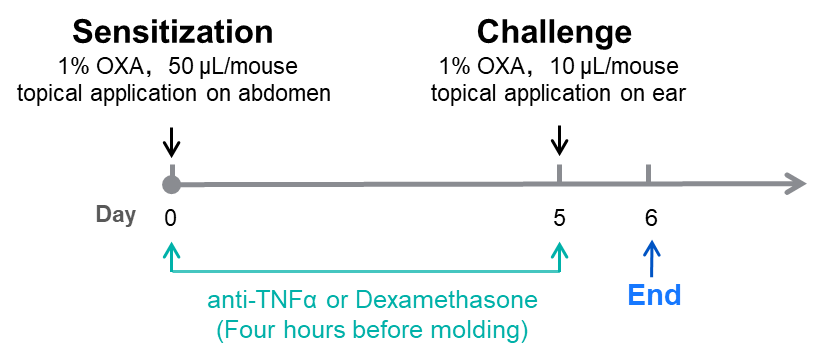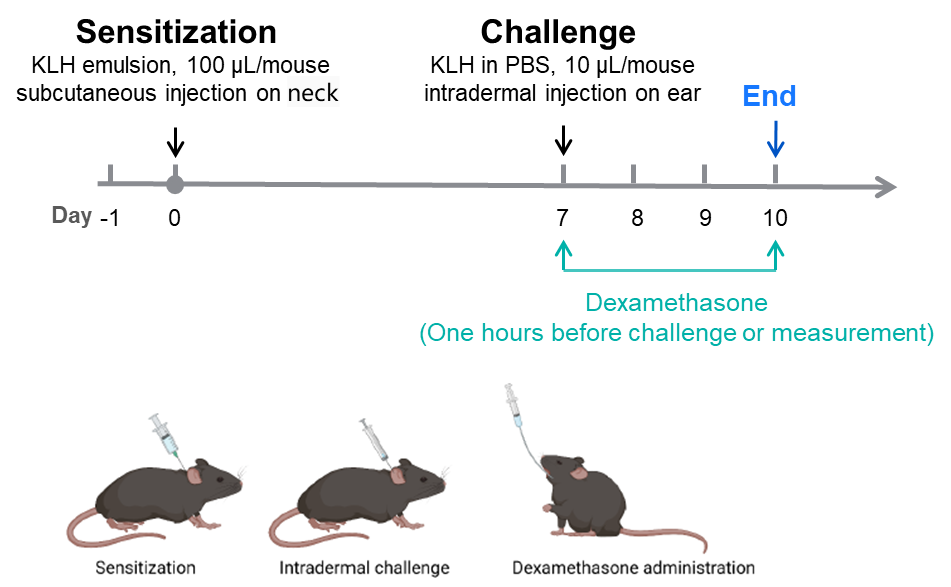迟发型超敏反应(Delayed-type hypersensitivity, DTH)是具有相应抗原[1]的效应T细胞作用后,以单个核细胞浸润和组织细胞损伤为特征的炎症反应。它通常发生在细菌和病毒感染、肿瘤疾病、移植排斥和接触性皮炎期间。小鼠接触性超敏反应是一种广泛用于研究T细胞介导的接触性过敏原免疫反应的模型。恶唑酮(OXA)是一种半抗原,应用于皮肤时可与皮肤蛋白结合形成完整抗原,刺激T淋巴细胞增殖为致敏淋巴细胞[2]。4 ~ 7天后再次使用奥沙利铂,局部可出现迟发性过敏反应。钥孔血蓝蛋白(KLH)是一种高免疫原性蛋白大分子,可使树突状细胞识别Th1细胞[3],是诱发迟发性超敏反应的理想抗原。KLH被系统性地引入小鼠体内。几周后再次局部注射,通过注射部位相对肿胀度评估迟发性超敏反应。Biocytogen建立OXA和KLH诱导的迟发性超敏反应(DTH)小鼠(Balb/c)模型,可用于免疫抑制剂疗效评价。
OXA-Induced DTH Mouse Model based on BALB/c Mice

KLH-Induced DTH Mouse Model based on C57BL/6 Mice

Efficacy Evaluation of Dexamethasone and Anti-TNFα in a OXA-induced DTH Mouse Model

Figure 1. Analysis of characteristics in DTH model based on BALB/c mice.
Ear Thickness (A) and Change of Ear Thickness (B) in BALB/c DTH model induced by 1% OXA. Values are expressed as mean ± SEM. **p<0.01, *** p<0.001

Figure 2. Histologic Assessment of DTH in BALB/c Mice
Efficacy Evaluation of Dexamethasone on KLH-induced DTH model

Figure 3. Dexamethasone alleviates KLH-induced an DTH phenotype in C57BL/6 mice. Body weight (A), (B) Ear Thickness. Values are expressed as mean ± SEM.

参考文献
[1] Honda T, Egawa G, Grabbe S, Kabashima K. Update of immune events in the murine contact hypersensitivity model: toward the understanding of allergic contact dermatitis. J Invest Dermatol. 2013. 133(2):303-15.
[2] Mchale J F , Harari O A , Marshall D , et al. Vascular endothelial cell expression of ICAM-1 and VCAM-1 at the onset of eliciting contact hypersensitivity in mice: evidence for a dominant role of TNF-alpha.[J]. American Association of Immunologists, 1999(3).
[3] Richerson HB, Dvorak HF, Leskowitz S. Cutaneous basophil hypersensitivity. I. A new look at the Jones-Mote reaction, general characteristics. J Exp Med. 1970. 132(3):546-57.
 苏公网安备:32068402320845号
网站建设:北京分形科技
苏公网安备:32068402320845号
网站建设:北京分形科技






 010-56967680
010-56967680 info@bbctg.com.cn
info@bbctg.com.cn